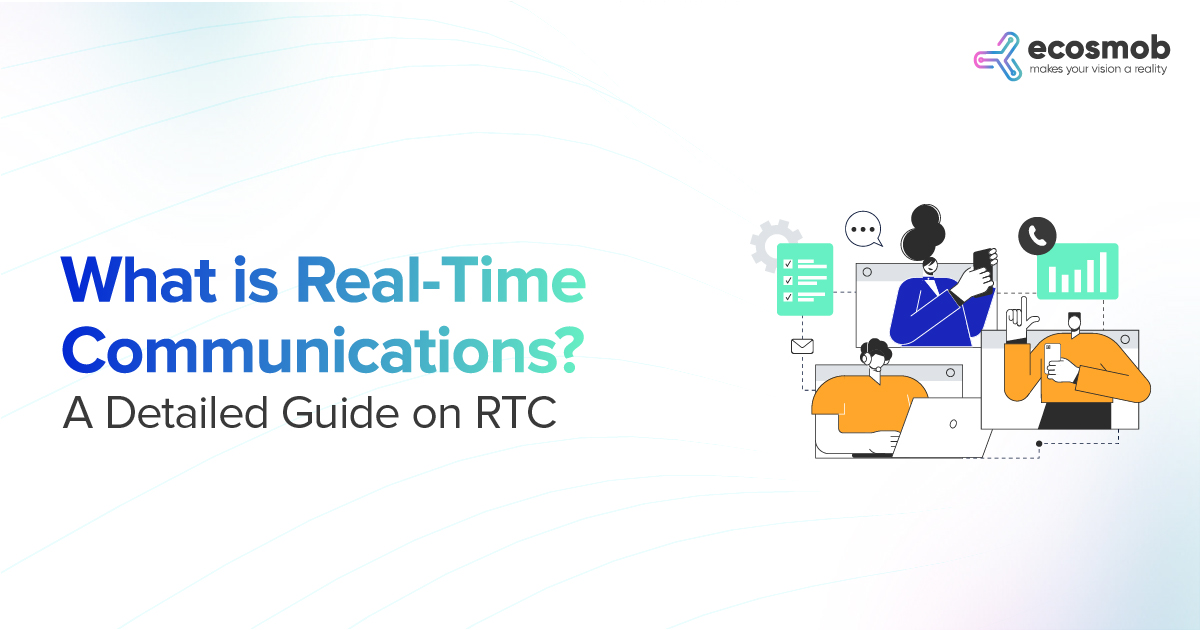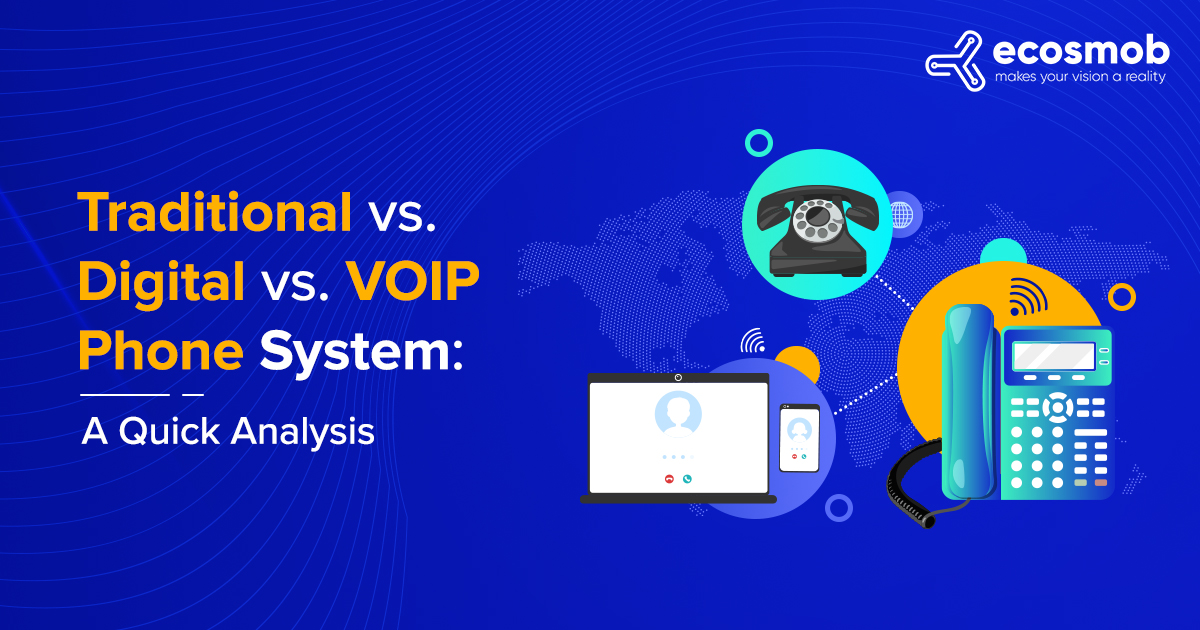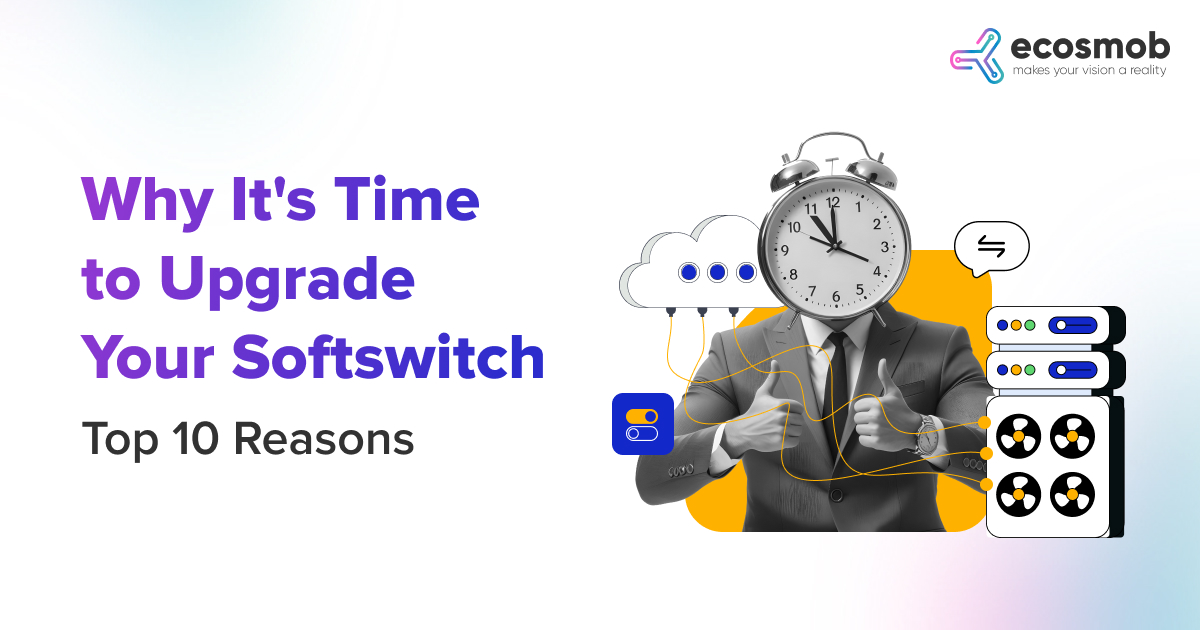Communication via technology is ever-changing and constantly evolving for the main benefit of users. Over the decades, phone systems have gone from analog to digital to Voice over Internet Protocol (VoIP). With this constantly changing technology, it is vital to keep educated to produce informed decisions that best fit your needs.
Today’s VoIP solutions provider offers a service that allows voice to carry over the Internet instead of via copper phone lines, a data connection.
The call-handling components of the original business VoIP providers were on-premises hardware, but in recent years, software-based VoIP solutions have also been accessible. However, When choosing a telephone system for your company, it is complex when comparing digital phones vs. VoIP vs. traditional phone services. In this post, we’ll offer you some information regarding the best option for your company that can help your bottom line. But before proceeding further, let’s understand digital phones, traditional phones, and VoIP phone services.
Traditional Phone System
Landlines are used in traditional phone networks, categorically regarded as the original, most reliable telephone technology. These systems use copper wiring and frequently include conventional functionality like hold, mute, and redial.
You will require so-called PBX hardware and the wire to operate a traditional phone system. For any phone calls made inside the corporate landline, the PBX hardware effectively serves as a central switching system and controls the flow of other calls. Due to their simplicity and high dependability, they are popular systems. Unfortunately, they may be expensive and do need upkeep.
Best For Big businesses with the resources to engage IT experts and maintain it regularly.
Worst For Budget-conscious companies or those seeking a little more high-tech.
Digital Phone System
Compared to analog, more conventional systems, digital systems are a little more advanced. The potential to add features and capabilities, like as hold music, VoIP integration, or alarm systems, is available with digital PBXs.
Most modern digital phone systems come with an Internet Protocol interface, enabling added functions like click-to-dial, voicemail delivery, and fax delivery to email.
Since calls still need to go through a phone room, even if this type of phone system primarily employs fiber optics rather than outdated copper wiring techniques, be sure to have someone on staff who is proficient at punching down digital sets.
Best For Companies who want a robust, reliable signal with good features.
Worst For Small enterprises that want to avoid extra frills or IT support outsourcing.
Want to Know More About VoIP Phone Systems?
VOIP Phone System
Voice over Internet Protocol, or VoIP phone system, does not utilize landlines’ conventional copper wiring. Instead, these phone systems digitally transmit the voice signal to a different phone or voice point using the internet and the same internet connection currently used throughout the business. They’re lovely for giving small companies access to many capabilities that were previously only available to larger enterprises. It includes computer connectivity, enabling all voicemails to be routed to email inboxes or using smartphones to grant remote employee access.
Comparing VoIP to analog or digital phone systems reveals that VoIP phone system is much easier to maintain. In contrast to those alternatives, VoIP systems can work remotely. VoIP is a very appealing alternative for users who need to make many long-distance calls because you use the internet to make calls.
Also Read: Tips to Choose the Best VoIP Solutions for Small Businesses
The one drawback of having a VoIP phone system at business is that if your internet connection goes down, your phone lines would also be a big problem.
Best For: Small businesses who desire cutting-edge services frequently place long-distance calls and want their phone system connected to the internet.
Worst For: Companies without an internet connection or who would be concerned if it dropped.
Traditional Vs. Digital Vs. VoIP Phone Systems
When determining the phone system for your requirements, you’ve three meaningful choices, Voice over Internet Protocol (VoIP), Digital, and traditional phone systems. To put it simply, VoIP is the data transmission over a signal connection versus a solid line (i.e., the internet).
Digital phone systems work using the prevailing phone lines with upgraded equipment, which makes phone lines suitable for current technology. At the same time, the traditional phone system is connected by wires, which can be complicated to maintain and make the workplace messy. We will now explain the budget, reliability, power consumption, bandwidth, maintenance, and mobility of your current telephone system, technology, and networking needs.
Hardware costs
Due to the necessary circuit cards, exclusive telephone sets, and auxiliary applications, digital phone system technology is more expensive than VoIP hardware. Applications are often triggered through software rather than additional hardware and are more likely to be integrated with VoIP equipment.
Users of VoIP phone systems frequently have a more comprehensive selection of endpoints because they are less often proprietary than they are on digital systems.
Traditional phone systems cannot be accessed remotely via an app and can only use with dedicated phones.
Wiring is Different
VoIP phone systems use the same connection that links a PC to the LAN at a user’s desktop, so the wiring is additional.
A voice cable and a data cable need for the digital phone system. Since the PC and VoIP phone share the same cable, less wiring is needed, which lowers the installation cost for the company.
Electrical pulses on copper lines need to transmit audio from one phone to another in a traditional phone system.
Power Consumption
VoIP phone system must connect to an AC power supply, which must connect to the phones. Since they utilize the power provided by the wire inserted between the phone and the digital circuit board, digital phone systems typically do not need to meet this requirement. While in traditional phone systems, PBX or VoIP switches’ power consumption rates while operating during a power outage.
Bandwidth
The VoIP phone system uses bandwidth sharing between phones and computers in office settings. Phones and PCs may not function properly due to insufficient bandwidth. The VoIP systems provide backup internet connections, allowing for more extraordinary office working flexibility. So the phone system continues to work flawlessly even when the Internet is out.
The relationship between the digital phone system and bandwidth is minimal. Therefore, there is no need to question if upgrading to a broadband connection is essential. While in a traditional phone system, there is no bandwidth requirement.
Maintenance
A professional must be present to do digital phone system maintenance. The VoIP phones enable anyone with admin access to log into the system remotely. It hosts VoIP phone systems that automatically update their software. Naturally, there is no on-site maintenance. VoIP phone systems can add new lines more quickly and easily without building wiring. While the traditional telephone system is user-friendly, so requires low maintenance.
Mobility
Customers value portability greatly, and VoIP meets their needs. If one uses a VoIP phone system, one must physically shift the phone to a new connection, and the phone number must follow suit. Naturally, office settings enjoy the freedom of working in such an environment. Using a digital phone system necessitates phone transfers, which are time-consuming because a call to the technician is required to move numbers to a new location. While in a traditional phone system, wiring by a qualified electrician is necessary when moving extensions.
Comparison between Traditional Vs. Digital Vs. VoIP Phone Systems
| Factor | Traditional | Digital | VoIP Phone Systems |
|---|---|---|---|
| At a Glance | Known as Legacy System | Proprietary to the PBX | A sort of Internet Protocol (IP)based digital telephony |
| Age | 1876 by Alexander Graham Bell | The late 1970s | Developed in 1995 |
| Basic Features | Call forwarding, Call routing, Caller ID, Call recording, and Emergency number | Analog primary features, LCD display, Caller ID, soft keys appearance | Basic Features, Advanced Features(Virtual auto attendants, Call forward, Voice mail, Conference Call, CRM Integration) |
| Cost | Expensive to install, implement and use. Increased efficiency of communication, and expensive to make international calls | Lower Upfront Costs. Expansion and international call costs are high | Initial spending is costly. Call rates are free or lower because it uses the internet |
| Set-up | Not easy to set up | Needs Professional Support | Initial spending is costly. Call rates are free or lower because it uses the internet |
| Wiring | Voice signal travels through copper wire to make and receive calls | Requires both a voice and a data cable | Plugged into an Ethernet |
| How it Works | Copper wires transmit electrical pulses that carry audio from one phone to another. | Transforms the analog voice signal into a digital signal (1s and 0s) before sending it across the connected line, decoding it to produce sound at the other end | To send the voice signal via the Internet to the chosen location, the voice signal is transformed into digital and divided into many packets |
| Power | Work during the power outage | Use little power from the phone line itself. Service terminates during a power outage | Use little power from the phone line itself. Service terminates during a power outage |
| Bandwidth | No Bandwidth Requirements | Use less bandwidth | Bandwidth is shared amongst computers and phones. Use less bandwidth. |
| Scalability | Lack of Scalability | Increase/Upgrade equipment or hardware is required over time. | Simple software upgrade. Additional lines are easy to set up but increase the need for bandwidth. |
| Maintenance | User-Friendly and Low Maintenance | Maintenance has to be done by a technician on-site | Anyone with administrator access rights can log in remotely to the system |
| Good For | Small Businesses | Home, SMBs | SMBs, Large Companies |
| Mobility | Rewiring by a qualified electrician is necessary when moving an extension | Getting a technician to transfer the numbers to the new location is necessary when switching phones | Simply physically moving the phone to a different connection is all it takes to move it, and the phone number is automatically updated. |
VoIP, Digital, and Traditional Phone System: Which Is Better for Business?
VoIP is the more convenient option after comparing all systems The VoIP phone system could be up and running within several hours or less, while the original usually takes days or weeks to set up. There is no need for a massive investment to get VoIP.
You can communicate with any employee working from home or traveling for business. You can also quickly reach any client, wherever you are.
But the ability to schedule a conference call might be the most intriguing feature. Twenty or more persons can reach their rooms, possibly in several cities or nations. Additionally, you can deliver a complete presentation via video conferencing.
Wrapping Up
Every company is aware of the value of its phone system. Although it has always been the customer’s lifeline, we can combine it with other corporate operations and processes to improve productivity and total customer relationship. After reading this article, you better understand how VoIP, digital, and traditional phone services vary. Every choice has a place in the discussion. But the truth is that a VoIP phone system’s functionality can be more than required if your entire team allocates in a single structure and most of your business is local.
If you still have concerns, Ecosmob Technologies will help you determine which phone option is best for your business. When working closely with our clients, we frequently offer cost/benefit analysis services that simplify contrasting your current phone system with alternative solutions. We also show customers how to use various telephone features.















